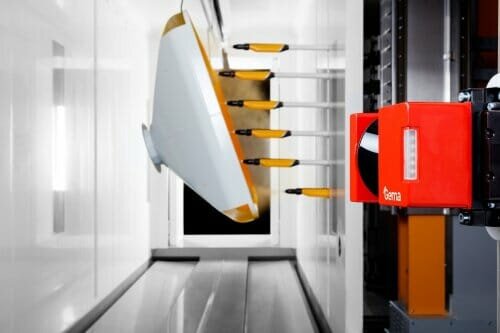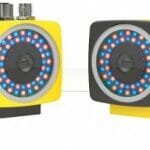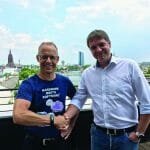High transfer efficiency, minimum powder output, uniform powder application: powder coating guns are at the core of powder coating. Electrostatic powder coating is a feasible alternative to wet coating for applications in various industries where large quantities are coated in the same color. At GEMA Switzerland, all system components through to the measuring sensors from Leuze electronic are precisely coordinated. This facilitates economical and ecological coating results as well as optimum working conditions.
Quality and ecology are top priorities
Quality and ecology are top priorities at GEMA Switzerland. The company maintains a modern coating laboratory at its headquarters in St. Gallen, Switzerland, where it conducts coating tests in cooperation with its customers. The test results are effectively incorporated in the planning of the complex coating systems and thus enable customer-specific and tailor-made solutions. “While the Graco Group (which GEMA Switzerland has been a member of since 2012) uses wet paint, GEMA Switzerland has specialized in powder coating and is the market leader in this field,” explains Axel Forster, Manager Controls & Automation at GEMA Switzerland. Well-known chassis, automobile and furniture manufacturers have elements such as engine parts, rims and furniture frames electrostatically powder-coated in large quantities in cabins manufactured by GEMA Switzerland. “This is not only more cost-effective and thus more economical than wet paint, especially when it comes to color homogeneity and high quantities, but also more ecological,” continues the HTL engineer, who studied at Rapperswil University of Applied Sciences.
Reliable part detection is imperative
All components involved in the powder cycle are coordinated in such a way that a continuous and consistent feed of powder is guaranteed. Powder coating itself takes place in so-called coating booths, which are designed in sort of a sandwich construction. The advantage of this is that only a small amount of powder sticks to the walls of the booth, and automatic cleaning of the floor of the booth prevents powder accumulations. Adjustable via a control panel at the cabin entrance, the powder coating process is controlled by the operator in such a way that only the necessary amount of powder is used and, above all, where it is used. This requires that the parts of the incoming carrier and the elements to be coated are reliably detected. In the past, the parts of the coated object were generally detected statically in regards to their size, position, and inclination. Static parts detection with measuring light curtains
The CML 720i EX measuring light curtains from Leuze electronic are used for static part detection at GEMA Switzerland. The control unit and interfaces are integrated in the receiver unit, which means that additional devices are not required. An important prerequisite for was to have a high-quality fieldbus system suitable for CAN bus, in which each individual light curtain represents a single CAN node, not a master-slave concept, explains Axel Forster. The light curtains are parameterized directly via the control system, which stores the parameters and facilitates exchange without re-parameterization. An alignment mode and a bar graph indicator for the received signal level are integrated in the display for fast and safe alignment. Due to the short response time per beam, even fast processes can be reliably detected. Another important requirement: due to the cleaning-intensive working environment, the light curtains used must meet strict cleanliness requirements. “A sturdy metal housing, explosion protection and an easy-to-read display with a robust membrane keyboard are mandatory,” says Axel Forster.
An optical distance sensor is used for dynamic measuring
In various customer cases in which larger objects such as entire crane axes had to be detected, static measuring with CML light curtains was no longer feasible. Measurement field lengths of more than three meters and ranges of up to eight meters as well as higher function reserves were required. But David Semprevivo, Key Account Manager at Leuze electronic, also had an answer to these challenges, in collaboration with the GEMA Manager for Controls & Automation: instead of the CML light curtains which were previously used, they first tested the Rotoscan ROD-4 optical distance sensor for object protection and dynamic measurement tasks from Leuze electronic for the one-sided measurement of complex and large components in the GEMA coating lab. This device works much like an area-scanning sensor. It optically and contactlessly scans the area in front of it and thus enables full-coverage object detection. The light beam is deflected via a rotating mirror and a semicircular area of 190° with a radius of up to 50 m is coated. The area is divided into two detection zones with radii of 15 meters each. One protective field can be freely defined in each of them. Detection zone pairs can be saved and switched in ROD-4. Different heights or protrusions can be defined. The Rotoscan continuously measures its environment and makes the measurement data available at the serial interface for further processing. At GEMA Switzerland, this function is used specifically for contour detection of the retracting carrier and the elements to be coated. In addition to better farsightedness, the optical scanner also enables improved height control thanks to the differently sized detection areas. This is thus sort of a “parking aid” in the coating booth.
Solutions also for safety requirements
Two years ago, dynamic measuring using the Rotoscan optical distance sensor was tested in a GEMA project in the Czech Republic. Now the scanner is part of the standard product range of GEMA Switzerland. The project participants agree: much like they have jointly solved the tasks and requirements in regards to dynamic measurement in the past, they will also tackle safety requirements together in the future. The safe variant of the optical scanner from Leuze electronic is called the RSL 400, which can safely monitor up to 270° with full coverage.








